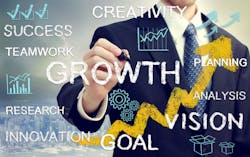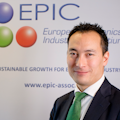Nanoimprinting gains momentum—An interview with Badre Kerzabi
Carlos Lee: What’s the background to you founding SOLNIL as CEO?
Badre Kerzabi: Having always been interested in technology, I studied a B.S., then an M.S. in physics with a major in photonics at the Institut d’Optique Graduate School in France. I had originally thought about doing a Ph.D., but instead took the opportunity offered by my double degree to go to Singapore to study an M.S. in photonics at Nanyang Technological University. Upon graduating in 2006, I stayed on in Singapore as an optical design engineer for Qioptiq, working on defense and high-end applications.
In 2008, I came back to France and for the next four years worked as an R&D systems engineer for DEAM SAS, a startup developing innovative display applications for automotive. Then, in 2012, as a result of DEAM relocating to China, I joined Sunpartner Technologies, a French photovoltaic (PV) glass technology company. I started as an optical engineer working on solar modules and later on nanoimprint lithography and display technologies, and finally in 2017, I became innovation program manager.
At that time, I was looking for a cheap way to fabricate colored solar panels either by using some kind of simple inks or some kind of interference layers. In the process of scouting for appropriate technologies, I met my future co-founders, who were developing a nanoimprinting technology to make structural colors. It was not mature enough for PV applications, but we identified other, more relevant applications for the technology, such as spectral sensing. Two years later, Sunpartner Technologies went into liquidation and was bought by the U.S. multinational, Garmin, where I stayed as a technology leader, helping to optimize solar energy harvesting for smartwatches and other wearables.
But over the next 12 months, I became increasingly frustrated. Although I was aware that nanoimprinting and nanophononics technology had a wide variety of applications, it would be impossible to explore them because it was beyond the scope of my job and outside the company’s business remit. As a result, in May 2020, I co-founded SOLNIL (Marseille, France) with the aim of developing the nanoimprinting of sol-gel materials for a variety of photonics applications.
CL: How are you different from your competitors?
BK: While nanoimprinting has been gaining momentum for many applications, it’s mainly used for polymers. But many applications require materials with better properties. For this reason, we are developing a new nanomanufacturing technology that makes possible the direct nanoimprinting of metal oxides through advanced sol-gel chemistry. Compared with polymers, metal oxides offer much better optical, thermal, and mechanical performances, so our technology is suitable for applications requiring miniaturized and engineered optical functions, such as multispectral imaging, 3D sensing, laser optics, augmented reality, metasurfaces, and gas sensing.
Additionally, unlike the traditional methods of etching using deep UV photolithography, with our technology we can mold directly onto materials such as silica or any kind of metal oxides.
As an example, in the case of multispectral, instead of making optical multiple layer stacks, we can imprint nano patterns in a one-step process, imprinting all of the color filters at the same time, which is a much faster and cheaper process.
CL: What are the advantages and disadvantages of being a CEO compared to an employee?
BK: The main advantage is that because you make the decisions, you can move faster, as you only need to convince the customer and you don’t need to spend time trying to persuade your boss or other departments within the company, which saves a lot of time and energy.
Being a CEO, you need to have a larger picture of the company and get involved in all of the aspects of running a business. In my previous jobs, there were quite a lot of arguments between R&D, marketing, and accounting, but now I have a better understanding of the position of my former colleagues. Paradoxically, if things don’t work and I have to go back to being an employee, it will be less of a drama because I now have a much better understanding of what other departments are trying to do.
CL: What have been your main challenges?
BK: Being a technical person and a bit on the shy side, I’ve had to work on my soft skills—particularly being a better communicator in convincing customers about the value of our technology. We’ve also tended to underestimate all of the administrative tasks that consume a lot of time.
But the biggest challenge has been understanding our limits and deciding when to outsource certain tasks and then finding the right partners to provide the service. At first, you only see the cost of the service, but with time you see the long-term benefits. For example, when I started, I thought I could do the market research myself. But I soon realized that I had neither the time nor the skills to do it, so we contacted companies such as Yole Développement who have proved very useful in moving us forward.
Similarly, it’s been difficult deciding when to ask for help or get coaching for some aspects of the business. Luckily, one of our co-founders has been involved previously in two startups and knows a lot about the pitfalls to avoid. We’ve also been able to get help from Impulse Incubator, which provides help and advice for French high-tech startups in Marseille’s area on all aspects of business, including the legal side, accounting, and finance.
Another challenge has been choosing the right applications to focus on. When we started out, we saw dozens of applications for our technology. Some, including augmented reality displays, were very exciting from a technical point of view, but for commercial reasons we decided to focus on laser optics and sensing because they had a clearer route to market and were more achievable.
CL: How do you see the future?
BK: Over the past 18 months, we’ve developed some really nice proof-of-concepts and we’ve identified the markets where we will have a strong value proposition. Although we have potential customers who are really interested in what we are doing, the next step is to show we can scale up to CMOS manufacturing environments. For example, if we want to go into high-volume markets for multispectral sensors used in smartphones, the filters will have to be deposited directly on top of the photodiode, which means we will have to be compatible with CMOS process flow on 200 mm wafers.
About the Author
Carlos Lee
Carlos Lee is Director General of the European Photonics Industry Consortium (EPIC; Brussels, Belgium), an active industry association that fosters a dynamic photonics ecosystem by maintaining a strong network and acting as a catalyst and facilitator for technological and commercial advancement.

